Traditionally, we have been pruning most of our stone fruits in late January along with the rest of the orchard for quite a number of years. A few years ago, we discovered something interesting in our Peach Plum. It has been my youngest daughter’s favorite plum since she was little, so we have always kept one for her enjoyment. Unfortunately it has been plagued by disease every year, and only producing a dozen or so fruits annually. So, I gave up and didn’t prune the tree. I made the decision to take the tree out in the summer when the spring rush was over. Much to my surprise and delight, the tree set over 200 lbs. of beautiful plums and in spite of being a very harsh disease year, Brown Rot was nearly non-existent and the tree was clean of disease. I also noticed in the peach block any shoot that was pruned expressed more disease strikes than its non pruned shoots in the same tree. In a few of our peach variety trials last year some of the pruned shoots lost over 40% of their buds to brown rot. So I started doing a little research and talking with some of the stone fruit scientists I have gotten to know over the years. Below is the new thinking about the timing for dormant pruning for most stone fruits.
What seems to be happening is the stone fruit branches lose their dormancy very quickly after they pruned. Meaning the buds soften and the branch is more susceptible to disease pressure that is present very early in the season waiting for your tree to wake up. Generally waiting until fruit set (petal fall) to prune can make a significant improvements in your tree health and productivity.
Pruning Plums
Plums are the most forgiving in the group of the stone fruits. Varieties like Methley and Fortune are very disease resistant and tolerant of early pruning. These are the only varieties we feel are safe to prune in the dormant season. Waiting until petal fall (fruit set) to prune for many varieties is also fine. Your tree will be begin to leaf out at a very rapid pace. It isn’t going to hurt your tree at all for you to wait and prune at this later time.
Pruning plums is fairly straight forward. Number one point: Your goal is to keep the tree open to light, and keep it in balance.
Plums can bear on one year wood and you can prune into one year wood without any reduction of fruiting buds. We recommend pruning to an open center on plums. This is usually how they want to grow. You can keep the height of your trees down by having multiple leaders soaking up the vigor. We don’t have the size options on plum rootstocks compared to apples. So you should expect your plums to grow to 10-15’ tall and wide. They are vigorous trees even on these semi-dwarf rootstocks.
To simplify the pruning, you want 3-5 leaders growing at roughly 60 degree angles. As the tree matures, you might want to reduce the leaders down to 3 or 4. You can always cut out more, it’s hard to put a limb back. So I leave in the extra leaders until they begin to crowd. Each year, it is important to keep these limbs/leaders balanced. Keep the fat wood low in the tree. So those shoots that are fatter and taller must be cut down to the same finished height as all the others. Cut preferably to a side branch that has a significant reduction in caliper. In a perfect world, all the main leaders will be the same caliper and height. You will know in a hurry if you leave one branch too tall; it will grow to tower over the others. This fortunately is fairly easy to correct; in mid-June to early July make a summer pruning cut where you think it will bring the branch back into balance. It will take about 3 weeks for that pruned shoot to repush.
Plums get brushy. In peaches we savor every live bud; in plums, you just have to prune, cut or strip off enough so light can get to all leaves on the tree. For the first 5 years or so I leave nearly all of the weak wood that pushes little short stubby shoots and lots of petite side buds. These are all going to be flower buds. My rule is any shoot less than 8″ I keep. And what do you do when these have piled on a limb every 3-4 inches? Thin these fruiting shoots and spurs so they are 8″-10″ apart.
Plums can be very biennial in bearing. Many plums are sold by other nurseries as self-fertile. This is true in the sense that you will get a half dozen plums a year, until the trees are quite mature. If you have a pollenizer you can get 160lbs in the “on” year and 60-80 in the “off” year. That second tree is a good investment if you are serious about growing fruit.
When you are pruning you will want to know if you are in an “on” or an “off” year. You will have to be more careful and maybe prune a little less in the “off” year.
Peach/Nectarine Pruning
Peaches and Nectarines need to be pruned quite hard every year in our climate. Unlike many other types of fruit tree, they produce flower buds on one-year (last summer’s) wood. By pruning hard, we encourage the vigorous growth of lots of new, fruitful wood. It also means that we encourage enough vigor that the tree can outgrow minor leaf curl infections.
Peaches should be pruned to an open center form. The pruning done on peaches is for
-
- Developing the leaders/main upright branches
-
- Heading cuts for quality fruit; reduces excessive crop, meaning less thinning, and increases fruit size and sweetness
- Heading cuts to create young wood for next year; on peaches and nectarines all fruit is produced on one-year wood. We are trying to create suckers- that’s the fruit wood on peaches and nectarines.
- Before pruning
- Same tree, after pruning
You want 3 or 4 main leaders in your tree. On young trees, you may need to remove extraleaders to develop the open vase structure. All of the leaders should be about the same height when you finish.
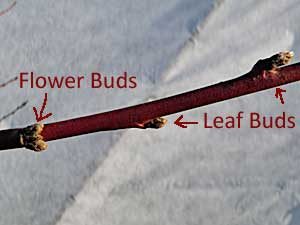 Strong shoots that grew last year and have lots of flower buds should be headed back to 5 or 6 flower buds. You can tell flower buds apart from leaf/vegetative buds by their shape. Flower buds will be rounded, and often will occur in pairs. Leaf/vegetative buds are more pointed and can be single or in pairs. Most of the flower buds will be toward the base of the shoot. Heading back this shoot limits the number of fruit on that shoot.
Strong shoots that grew last year and have lots of flower buds should be headed back to 5 or 6 flower buds. You can tell flower buds apart from leaf/vegetative buds by their shape. Flower buds will be rounded, and often will occur in pairs. Leaf/vegetative buds are more pointed and can be single or in pairs. Most of the flower buds will be toward the base of the shoot. Heading back this shoot limits the number of fruit on that shoot.
Shoots that are mostly leaf/vegetative buds should be headed back to 2-4 buds to encourage young shoot growth. These young shoots will bear the following year’s crop.
Thin out weak shoots and branches that did not push vigorous shoots when headed back last year.
As you prune your Peaches and Nectarines, Recap
- You want to keep strong, unbranched one-year shoots. These are the most productive branches. Prune out all of last year’s shoots that have many side branches. These will never be productive.
- Choose strong shoots as leaders. Head back to stiffen so they don’t lose their angle in the tree. In peaches and nectarines, upright branches are better than very flat branches.
- In pruning Peaches and Nectarines, treat each main branch as a leader. All leaders in an open center tree should end up at roughly the same height. Weaker (smaller caliper) shoots can be a little taller than fatter shoots .

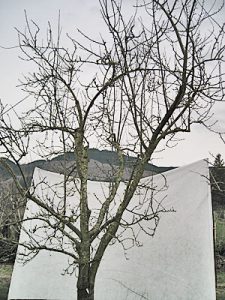
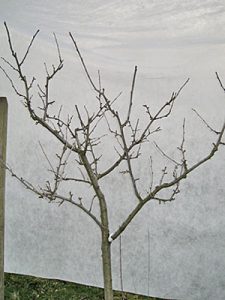
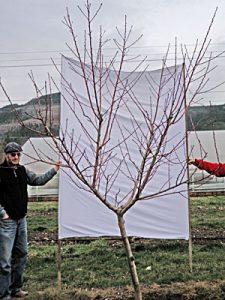
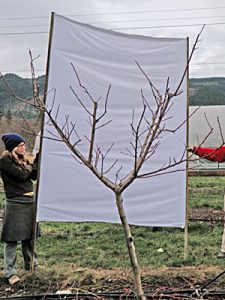

I have two Florida kings and two Florida Queens. They four years old I have yet made a crop of peachs. This spring 2020 they budded out about middle of March some flowers opened up an some didn’t very little fruited. I fertilized them in February and again april. I have four trees they all have each four or five main scoffs at 45 degrees. But on each tree I have a center leader go straight up . Could I prune them out now are wait in should wait until there are dormant. The leaders are 2 and half inch. I lI’ve southwest louisiana. We get anew advantage of 300 to 350 hours below 45 degrees. Please help if you can. James kibodeaux.
I can’t speak well to trees grown in such a different climate. We prune during or after bloom to lessen frost damage. Buds that fail to open could also be a disease issue. You might contact your local master gardeners or Ag university extension office for more regional knowledge.
Does this mean remove those secondary “branches” or remove the entire shoot which is much thicker that grew the same year before those secondary branches grew on it.
“You want to keep strong, unbranched one-year shoots. These are the most productive branches. Prune out all of last year’s shoots that have many side branches. These will never be productive.”
When thinning branches, remove the entire branch with sylleptic shoots (secondary branches that grew in the same growing season). If you’re unsure what branches will be productive, watch the tree bloom, then prune afterwards during dry weather.
Hi,
Regarding pruning after fruit set. I’d like to know based on your orchard observations, does pruning after fruit set makes the tree drop/abort fruits due to disappearance of much of leaves that the tree was counting on to mature the fruits and impact new shoots it should grow for next season. Assuming the fruitset happens in April for PNW, is that timing too late?
I also like to add the pruning guide (link below) from Virginia tech advices to delay pruning peach trees in winter. However, they don’t specifically say when to prune.
https://www.pubs.ext.vt.edu/422/422-020/422-020.html
See this article from UC davis on fruit development. Properly thinning the canopy to allow light to penetrate to the existing fruiting spurs will give better fruit quality. Pruning after bloom allows doubles as thinning the fruit, improving the quality of the remaining fruit while maintaining the size and structure of the tree. April is not too late in our climate. We have delayed pruning stone fruit until June in years with incessant spring rains. In our experience, the best time to prune stone fruit is after bloom during dry weather.
Thank you.